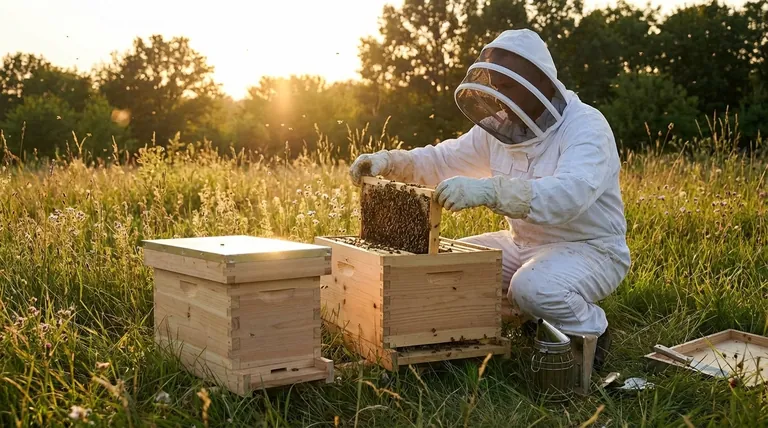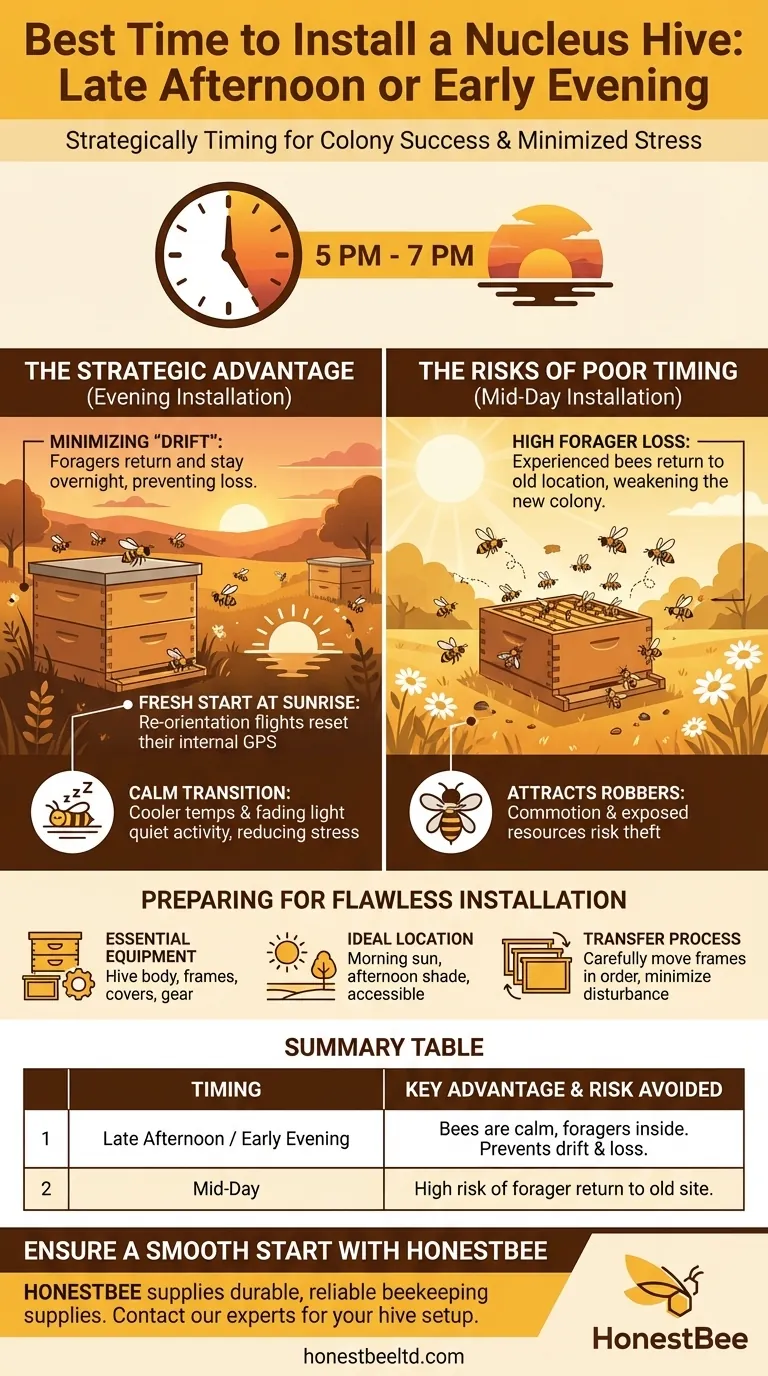The best time of day to install a nucleus hive is late afternoon or early evening. This specific timing is a critical factor for success, as it leverages the natural behavior of honeybees to ensure the colony remains intact and settles into its new home with minimal stress.
The core principle is simple: install your bees when they are naturally finishing their work for the day. This prevents the colony's experienced foragers from getting lost and gives the entire hive a calm, overnight period to acclimate before their first full day in their new location.

The Strategic Advantage of an Evening Installation
Choosing the right time to move your bees isn't arbitrary; it's a strategic decision that directly impacts the colony's stability and strength. The goal is to make the transition so smooth that the bees barely notice the change in address.
Minimizing "Drift"
A nucleus hive contains a small but complete colony, including forager bees that have already oriented to their original location.
If you install the nuc in the middle of the day, these foragers may fly out and instinctively return to the empty spot where their old hive was, becoming lost and depleting the new hive's workforce.
By waiting until evening, you ensure nearly all the foragers have returned for the night. They will stay inside the new hive until the next morning.
A Calm Transition Period
The cooler temperatures and fading light of evening naturally quiet the colony's activity.
This calm environment encourages the bees to focus on their new immediate surroundings—the frames, the queen, and the brood—rather than immediately taking flight.
This overnight period allows them to reorganize, accept the new hive box as their own, and establish their scent throughout the interior.
A Fresh Start at Sunrise
When the bees emerge the following morning, they will perform re-orientation flights.
They will fly in circles in front of the new hive entrance, mapping its specific location. This process effectively resets their internal GPS, locking in the new hive as their home base.
Preparing for a Flawless Installation
Proper timing is crucial, but it's only one part of a successful installation. Having your equipment and location ready beforehand makes the process quick and stress-free for both you and the bees.
Essential Hive Equipment
Before your nuc arrives, have your complete hive assembled and in place. You will need a hive body, a bottom board, frames (to fill the rest of the box), an inner cover, and a main cover.
Don't forget your protective gear, including a bee veil, suit, and gloves.
Selecting the Ideal Hive Location
Choose a site that receives morning sun to encourage early foraging but offers some protection from intense afternoon heat.
Ensure the location is easily accessible for your future inspections and shielded from strong winds and potential predators.
The Transfer Process
The physical installation involves carefully moving the frames from the nucleus box into your new hive body in the same order and orientation they were in before.
Work smoothly and deliberately to minimize disturbance. Once the frames are transferred, add your remaining frames to fill the hive box, place the covers on, and leave the bees to settle.
Understanding the Risks and Trade-offs
While evening is ideal, understanding why other times are less suitable reinforces the best practice and helps you troubleshoot potential issues.
The Risk of a Mid-Day Installation
Installing a hive midday is the most common mistake. It leads to significant forager drift, permanently weakening the new colony.
The commotion can also attract robber bees from other hives if there is a nectar dearth, putting your new colony at immediate risk.
The Importance of Weather
The ideal installation day is calm, clear, and warm. Avoid installing a nuc during rain or high winds.
Poor weather can chill the brood and stress the colony, compounding the disruption of the move itself.
Ensuring Post-Installation Resources
Your new colony will need immediate access to food and water to draw new comb and feed the brood.
If there isn't a strong nectar flow, be prepared to provide a 1:1 sugar water solution in a hive-top or entrance feeder.
Making the Right Choice for Your Goal
Your actions during installation set the stage for the colony's entire season. Tailor your approach to ensure a strong and productive hive.
- If your primary focus is bee retention: Install the hive in the late afternoon or early evening, without exception, to ensure your forager workforce stays with the colony.
- If your primary focus is colony health: Ensure the transfer is smooth and calm, you place the hive in a well-chosen location, and you provide immediate access to food and water.
Ultimately, a successful nuc installation is a quiet, deliberate event that aligns with the natural rhythms of the honeybee.
Summary Table:
| Timing | Key Advantage | Key Risk Avoided |
|---|---|---|
| Late Afternoon / Early Evening | Bees are calm; foragers are inside for the night. | Prevents forager drift and loss. |
| Mid-Day | - | High risk of foragers returning to old location, weakening the colony. |
Ready to ensure a smooth start for your bees? A successful installation begins with the right equipment. HONESTBEE supplies durable, reliable beekeeping supplies and equipment to commercial apiaries and beekeeping equipment distributors through our wholesale-focused operations. Let us provide the foundation your new colony needs to thrive. Contact our experts today to discuss your hive setup requirements.
Visual Guide

Related Products
- 5 Frame Wooden Nuc Box for Beekeeping
- HONESTBEE Professional Multi-Functional Hive Tool with Ergonomic Wood Handle
- HONESTBEE Advanced Ergonomic Stainless Steel Hive Tool for Beekeeping
- HONESTBEE Professional Long Handled Hive Tool with Precision Cutting Blade
- Multi-Function Plier-Style Frame Grip Hive Tool
People Also Ask
- What are the benefits of moving nuclei around the apiary? Master Strategic Hive Management
- What frames should be moved into the queenless hive when requeening with a nuc? Ensure a Successful Queen Introduction
- How should the nuc be installed in the apiary? Ensure Colony Success from Day One
- What is the advantage of overwintering a nucleus? A Strategic Asset for Beekeeping Success
- What are the benefits of using nucs for beginning beekeepers? Ensure a Successful First Hive with a Head Start



















